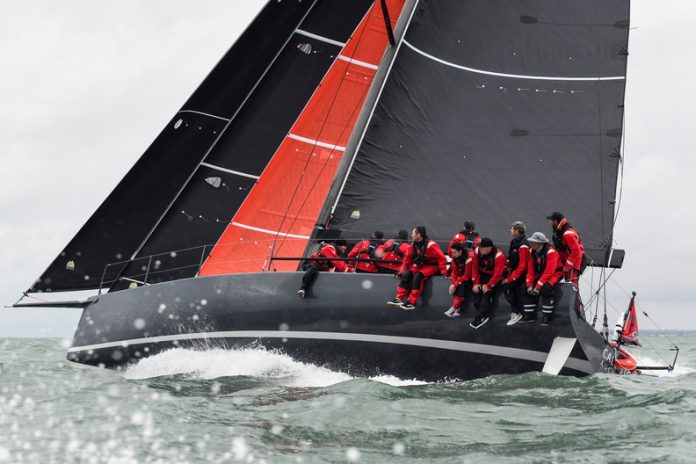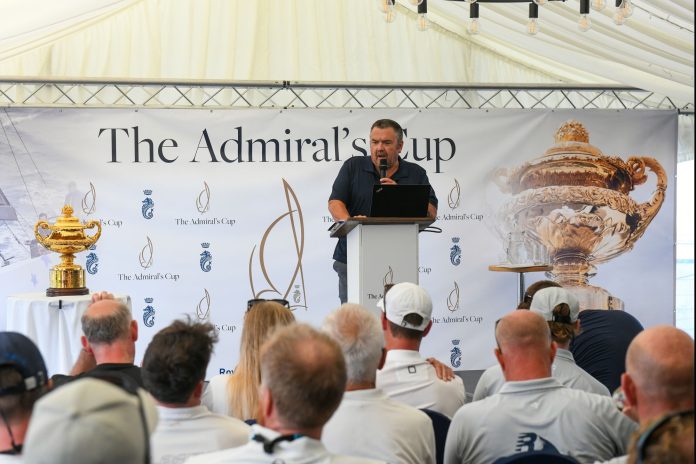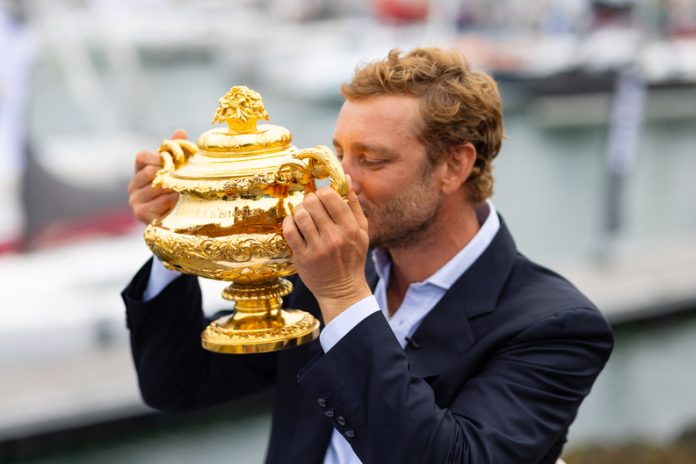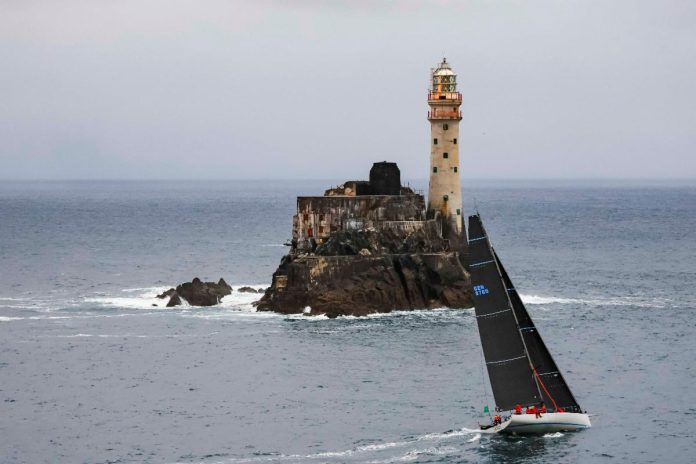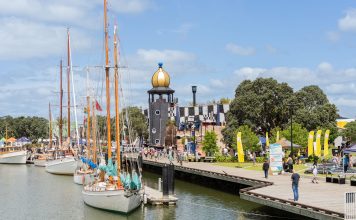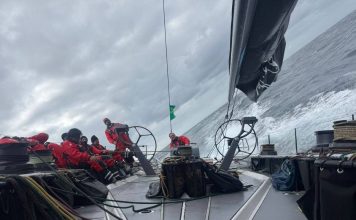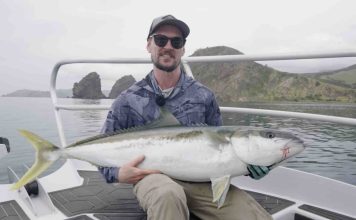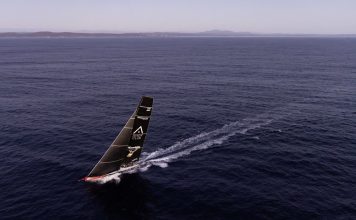The 2025 Admiral’s Cup is already proving its reputation as offshore sailing’s most demanding test of discipline, teamwork, and national pride.
After a 22-year absence, the legendary Cup roared back to life yesterday (Saturday, 19 July) with the Channel Race, a 160+ nautical mile overnight sprint from Cowes through the English Channel and back. But the day began not with gunfire, but rain.
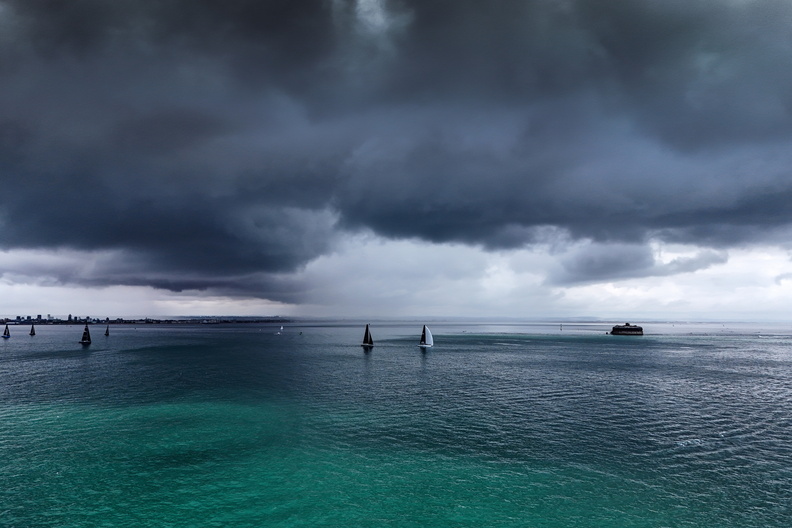
The Channel Cup
RORC Admiral’s Cup 2025
Cowes
Photo: James Tomlinson
A stormy start for a historic return
Originally scheduled to begin at 10:30 am BST, the Channel Race was delayed nearly three hours due to torrential rain, thunder, erratic winds, and near-zero visibility in the Solent. Race officials ultimately called for a revised start time of 12:10pm, prioritising safety as the fleet of 30 Admiral’s Cup contenders (and additional RORC Cowes Offshore Series contenders) jockeyed for clear air and clean lanes off the Royal Yacht Squadron line.
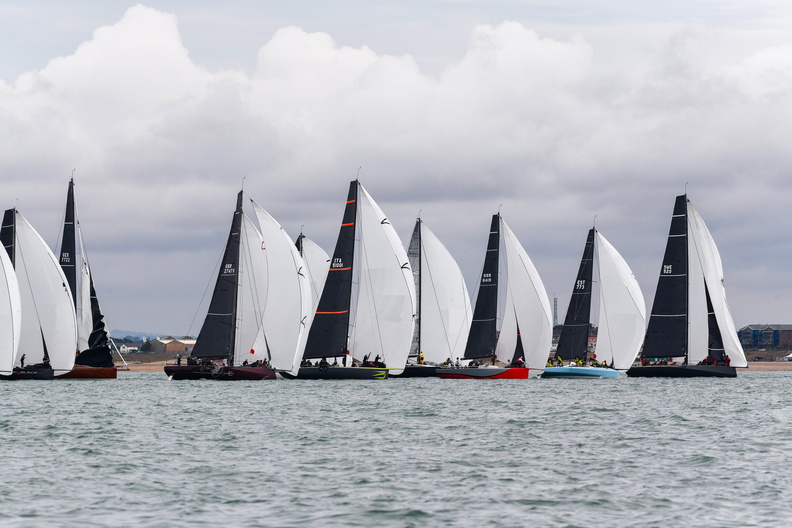
RORC Admiral’s Cup 2025
Cowes
Photo: James Tomlinson
The rescheduling meant competitors faced an evolving breeze and a hastily plotted racecourse. That mix of unpredictability and pressure made for a true Admiral’s Cup classic. With a 1.5× points multiplier in play—heavier than any inshore race but lighter than the Fastnet—the Channel Race wasn’t just the opener, it was a tone-setter.
And what a tone it set.
Tight times and shifting tides: the early leaderboard
Corrected-time results rolled in as dawn broke over the Solent. By 08:00 Sunday, the first boats had finished, and the top 20 had locked in corrected times, offering a tantalising glimpse into early team standings.
Tight margins, tense matchups: Channel Race delivers on Day 1 of Admiral’s Cup
RNZYC’s Callisto leads Admiral’s Cup 2 class – and the race overall
New Zealand’s Callisto (NZL) delivered a masterful performance in Admiral’s Cup 2 (AC2), finishing with a corrected time of 1d 0h 34m. It was the top result across both divisions at the time of writing—an exceptional achievement for James Murray’s rejuvenated GP42, which led a tight field including Jolt 6 (Monaco) and Beau Ideal (Hong Kong). For Kiwi fans, this is a big early signal: the RNZYS campaign is here to win.
“One race down, and Callisto is doing exactly what we hoped—steady, smart, and fast under pressure,” said one New Zealand team insider on Sunday morning.
The Kiwi duo’s other half, Caro, had a quieter outing. The Botin 52 was invisible on trackers for the first leg—likely due to a transponder issue—but eventually placed 8th in the Admiral’s Cup 1 class, just behind Australia’s Zen and Germany’s Red Bandit.
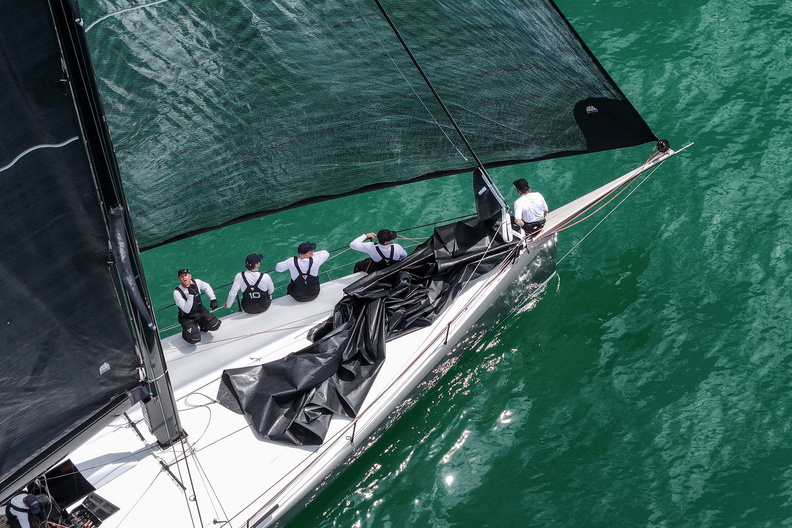
The Channel Race
RORC Admiral’s Cup 2025
Cowes
Photo: James Tomlinson
Admiral’s Cup 1: Django pips Beau Geste
In Admiral’s Cup 1, it was Italy’s Django WR51 that stole the spotlight, taking line honours in class with a corrected time of 1d 1h 14m. The custom Wally Rocket outpaced early leaders like Hong Kong’s Beau Geste, Sweden’s Rán, and Monaco’s Jolt 3—all tipped as front-runners pre-race.
Beau Geste, with Gavin Brady and Simon Daubney onboard, crossed second in class (with sister yacht, Beau Ideal, third overall.) Though not quite the hammerblow opening they might have envisioned, both Hong Kong entries—Beau Geste and Beau Ideal—remain quite firmly in the hunt.
Germany also had a strong showing, with Red Bandit, Imagine, and Ginkgo all placing well in corrected time. While Ginkgo and Albator topped provisional results earlier in the day under low IRC ratings, their final standings slipped slightly as faster boats clocked in.

The Channel Cup
RORC Admiral’c Cup 2025
Cowes
Photo: James Tomlinson
Admiral’s Cup 2: Callisto edges Jolt 6 as Kiwi campaign takes early control
In Admiral’s Cup 2, New Zealand’s Callisto stole the march on the fleet, finishing first in class with a corrected time of 1d 0h 34m. The modified GP42, skippered by James Murray and backed by a heavyweight Kiwi crew including Dean Barker and Mike Sanderson, delivered a sharp, consistent performance from start to finish—earning early honours for the Royal New Zealand Yacht Squadron and putting the team at the top of the overall leaderboard.

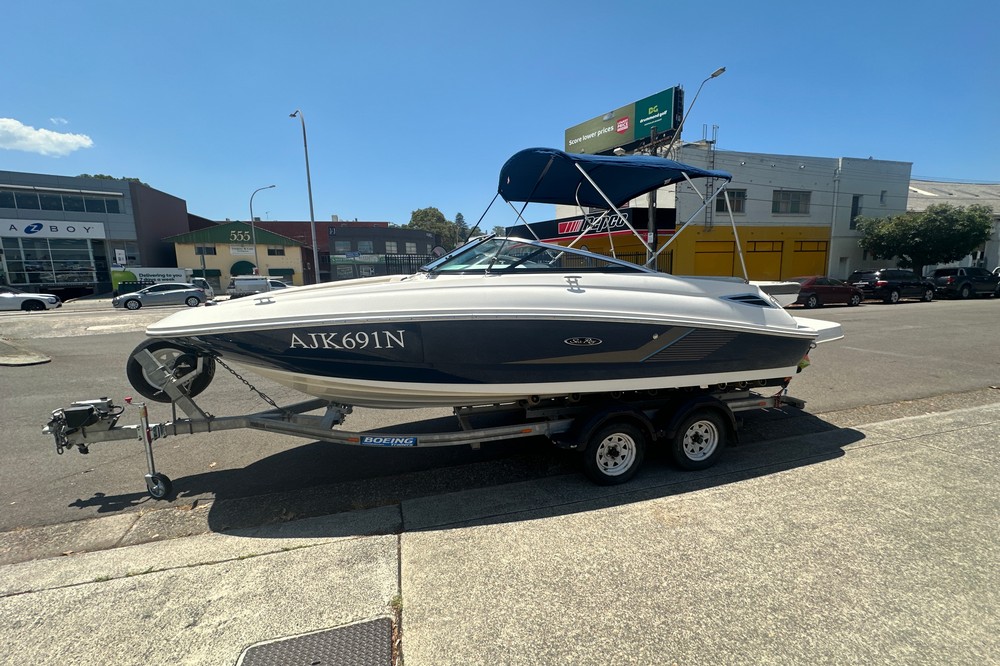
Just behind was Jolt 6 from Monaco, finishing second in class and runner-up overall. The Yacht Club de Monaco entry was one of the first to finish on elapsed time and remained in close contention throughout the rating adjustments. With Jolt 3 placing inside the Admiral’s Cup 1 class top five, Monaco’s squad looks well-poised for a strong two-boat campaign.
Beau Ideal, the minimalist Botin 40 representing Hong Kong, rounded out the top three in Admiral’s Class 2. Designed for simplicity and versatility, the boat proved its offshore credentials with a smartly managed race. With sistership Beau Geste also on the Admiral’s Cup 1 podium, the Hong Kong effort has started on a strong footing.
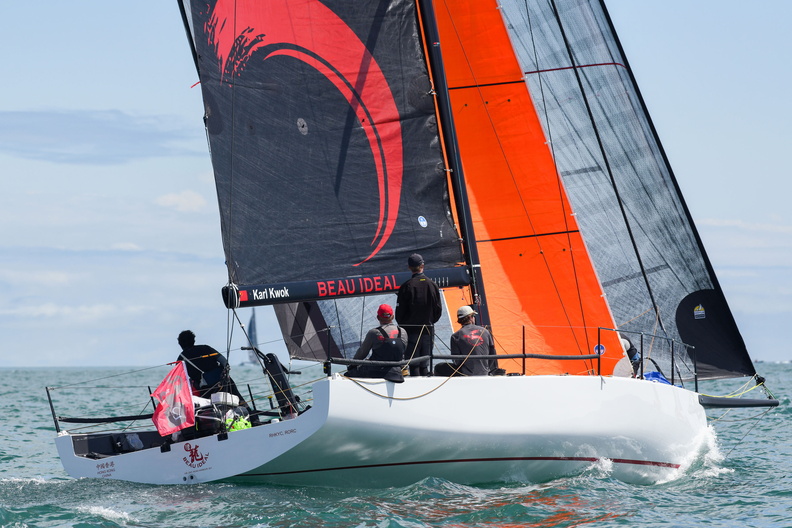
The Channel Race
RORC Admiral’s Cup 2025
Cowes
Photo: James Tomlinson
Further back, AMP-Lifi (GBR) and Back 2 Black (AUS) placed fourth and fifth respectively. Both boats were seen as pre-race contenders, and while they didn’t quite deliver knockout results in the Channel Race, they remain within range of the leaders heading into the second offshore leg.
Australia fades after early surge
Zen and Back 2 Black, the Australian entries, looked potent early on. Zen led corrected time standings for several hours overnight, but as dawn gave way to fresh finish times, the leaderboard reshuffled. Zen would eventually place 7th in Admiral’s Cup 1, while Back 2 Black came in 5th in Admiral’s Cup 2.
Although the Australian’s will need to pick up the pace a little, both results are within striking distance—and with the Fastnet carrying double points at the end of the regatta, no team is out of the running yet.
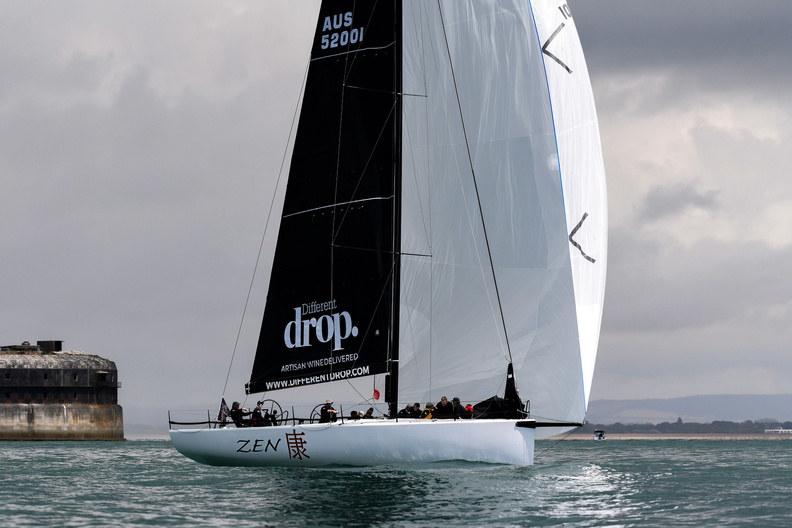
The Channel Cup
RORC Admiral’s Cup 19 July 2025
Cowes
Photo: James Tomlinson
A return to form—and fierce national rivalries
This Channel Race marks a successful reintroduction of Admiral’s Cup team scoring, with every club represented by two boats across Admiral’s Cup 1 and Admiral’s Cup 2 classes. That structure creates new dynamics: it’s not enough for one boat to shine—teams must deliver consistent, combined performances to stay competitive.
At this stage, Germany appears best positioned, with multiple teams placing both boats in the top 10. New Zealand holds an early advantage thanks to Callisto’s win, but Caro’s mid-fleet finish leaves them needing a strong result in the next leg. It’s not clear whether there was an issue for Caro at the start of the race, but we remain confident that Caro will place much better in further races. Hong Kong, Monaco, and Italy are also showing depth and balance across their pairings.
Meanwhile, early crowd picks like AMP-Lifi (GBR), Rán (SWE), and Privateer (USA) sit just outside podium range—still close enough to challenge, but no longer controlling the tempo.
What’s next?
We will return to the results once all the teams have finished; this might provide a slightly different story. Still, Callisto will remain the race winner. Congratulations to Callisto and her crew on her well-executed race.
Beyond today’s end of race, the Admiral’s Cup continues with a second short offshore leg, followed by three days of inshore racing next week. After that, the grand finale looms: the Rolex Fastnet Race, starting 25 July, with 2.0× points on offer.
The Cup isn’t won on Day One—but it can be lost here. With leaderboard positions already tightening, tactical discipline and team consistency will be key through the Solent sprints ahead.
Boating New Zealand will be tracking the Kiwi teams closely. And with Callisto now a confirmed contender, the dream of returning the Admiral’s Cup to New Zealand—nearly 40 years after our historic 1987 victory—is still very much alive.
“The Forgotten Cups”? Why offshore racing is stealing the spotlight








